Invasive Species
go.ncsu.edu/readext?830067
en Español / em Português
El inglés es el idioma de control de esta página. En la medida en que haya algún conflicto entre la traducción al inglés y la traducción, el inglés prevalece.
Al hacer clic en el enlace de traducción se activa un servicio de traducción gratuito para convertir la página al español. Al igual que con cualquier traducción por Internet, la conversión no es sensible al contexto y puede que no traduzca el texto en su significado original. NC State Extension no garantiza la exactitud del texto traducido. Por favor, tenga en cuenta que algunas aplicaciones y/o servicios pueden no funcionar como se espera cuando se traducen.
Português
Inglês é o idioma de controle desta página. Na medida que haja algum conflito entre o texto original em Inglês e a tradução, o Inglês prevalece.
Ao clicar no link de tradução, um serviço gratuito de tradução será ativado para converter a página para o Português. Como em qualquer tradução pela internet, a conversão não é sensivel ao contexto e pode não ocorrer a tradução para o significado orginal. O serviço de Extensão da Carolina do Norte (NC State Extension) não garante a exatidão do texto traduzido. Por favor, observe que algumas funções ou serviços podem não funcionar como esperado após a tradução.
English
English is the controlling language of this page. To the extent there is any conflict between the English text and the translation, English controls.
Clicking on the translation link activates a free translation service to convert the page to Spanish. As with any Internet translation, the conversion is not context-sensitive and may not translate the text to its original meaning. NC State Extension does not guarantee the accuracy of the translated text. Please note that some applications and/or services may not function as expected when translated.
Collapse ▲Plant Database
Non-native invasive plants can cause big problems for native plants and animals. Biologists and other scientists now commonly refer to invasions by non-native plants as one of the most serious problems facing native plant and wildlife populations in the United States. But how do these invasions occur?
What is a native plant and what isn’t?
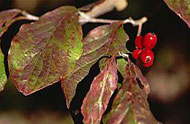
The native flowering dogwood produces fruits eaten by wildlife.
Native Plants are defined as any plants that occurred in North America before European settlement.
Non-native plants, are those not originally located in North America or in a specific region, like North Carolina. In North Carolina, there are many non-native plants from Asia or western Europe because these regions have similar climates and environmental conditions to those found in the state.
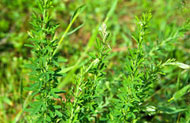
Sericea lespedeza is an non-native plant introduced from Asia.
Now, how did all these non-native plants get here? While some non-natives have ended up here accidentally, we brought most of them here ourselves, on purpose. Many non-native species were brought here for use as ornamental, lawn, and garden plants. They were chosen for their attractiveness and hardiness. Some of these non-natives have been here so long that we don’t even realize they are not native. Callery ‘Bradford’ pear, Chinese privet, Japanese Honeysuckle, and Queen Anne’s lace have become such common sights that we tend to think of these plants as native, but they aren’t. Other plants, such as multiflora rose, bicolor lespedeza, and autumn olive were even introduced for the purpose of promoting “wildlife habitat”. However, each introduction has proven detrimental in some ways to North Carolina’s native plants and wildlife.
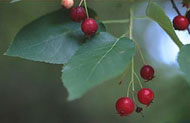
Native animals favor the fruits of native serviceberries.
Native plants are better for native wildlife. Over thousands of years, native plants and animals have evolved together. Natural checks and balances developed in the environment, reducing the chance that a single plant species will increase in number to the point where it completely dominates a plant community. Competitors, diseases, and insects control a plant’s growth and dispersal throughout the native range.
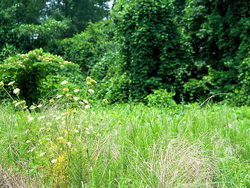
Kudzu, mimosa, and other invasive plants dominate a patch of land.
Without natural checks, non-native plants can become invasive. The same characteristics that make many non-native plants attractive in urban landscapes – colorful berries, pest resistance, and tolerance to harsh conditions – make them difficult to contain. Non-native plants that are attractive to birds and other wildlife are often the most invasive because animals serve as great dispersers of fruits and seeds, often moving the seeds great distances away from where the fruits were eaten. Autumn olive is a non-native plant that produces fruits favored by birds, but the plant grows and often spreads quickly where the seeds are defecated. When a non-native species becomes “naturalized,” or when that plant is able to survive, spread, and reproduce on its own, it can invade the native habitat and crowd out native species. Approximately 25% of the plants growing wild in the United States are naturalized non-natives, some of which have become invasive, growing uncontrolled where native plants otherwise would occur. Native fruit-producing plants may succumb to the competition from this type of invasive non-native, thereby reducing the diversity of foods available to birds and other wildlife.
Native plants are never invasive. The term invasive applies only to non-native plants and not to native plants; invasive implies a negative effect on native plants and animals. On the other hand, native plants that establish quickly in your garden and spread readily are more appropriately termed “aggressive”. Aggressive native plants generally are species adapted to recently disturbed sites where they establish and spread quickly but give way to other native plants within a few years.
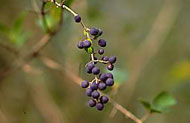
Birds eat Chinese privet fruits and disperse the invasive plant’s seeds.
Invasive plants can be attractive to wildlife, but not good for them. Non-native fruits, while attractive to wildlife, may not provide the best nutrition for native wildlife. Areas covered with only a few invasive, non-native plant species can be harmful because habitats with low plant diversity are poor for wildlife. New evidence from the mid-western United States indicates birds that nest in some non-native shrubs experience poor nesting success. Lower nest height, the absence of sharp thorns on non-native plants, and different branching patterns can allow predators easier access to nests built in non-native plants.
Not all non-native plants are invasive. There are many non-native plants that do not become invasive, and many can safely be planted in your landscape. However, it takes scientists many years or even decades to fully understand a non-native plant’s potential invasiveness. New information is being gathered, and you should check with your local nature center, botanical garden, or Cooperative Extension agent to find out about a plant’s invasiveness before introducing it to your property. There are a number of plants that we already know are invasive and that pose the greatest risk to the native plants and animals of North Carolina. Yet despite the growing base of knowledge related to the potential problems of non-native plants, species like sawtooth oak continue to be recommended as plantings to encourage wildlife. Until adequate information on the invasiveness of such plants exists, native alternatives should be used.
Invasive plants that you should avoid introducing into your landscape


